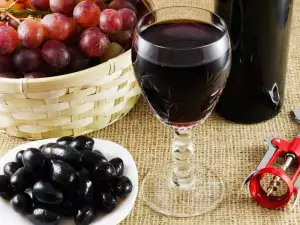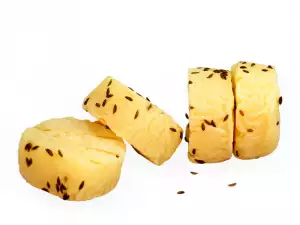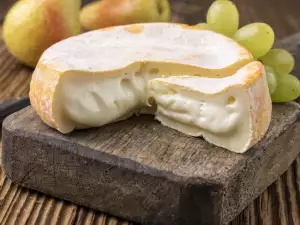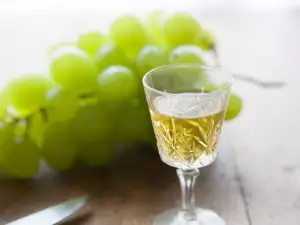Petit Verdot is a red wine grape variety, primarily characteristic of France, and more specifically of the region of the port city Bordeaux. But the delightful wines that are made from the variety have become reason for it to be grown in many other places in the world.
Currently, Petit Verdot can also be found in Italy, Spain, Chile, New Zealand, Argentina, Australia, the US (modest vineyards are seen in Colorado, Texas, Virginia, Missouri, Washington and North California), Venezuela, South Africa and others. Petit Verdot is a variety known by many names, including Petit Verdot Noir, Heran, Bouton, Lambrusquet Noir, Verdot Rouge and others.
As with all grape varieties, Petit Verdot has distinctive characteristics. Its leaves are light green, pedate, with triangular serrations. The cluster is small to medium, not particularly firm, reminiscent of a cylinder or cone. The grapes are tiny. They are rounded, colored dark blue to red, covered with a thick wax coating. The flesh of Petit Verdot is pleasant tasting, watery, releasing a whitish juice. A dense skin covers the flesh. The acid and sugar contents are satisfying.
Even though the variety is grown in no small number of areas throughout the world, in general the largest scale vineyards can be found in France. This is due in some part to the fact that the variety ripens later in comparison to other varieties such as Syrah, Cinsault and Pinot Noir for example. Ripening of Petit Verdot occurs in the fall, after the 2nd week of September.
Very often however, the variety does not ripen well. Among winemakers there is a belief that it ripens only once every 5 years. Characteristic of these vines is medium growth and relatively low yield. Another downside is that they don't always manage to fight off powdery mildew. Leaves attacked by it are covered in spots with a greyish wax. They are damaged and remain on the vines.
History of Petit Verdot

It is believed that Petit Verdot is something of a precursor to varieties such as Sauvignon, as well as those grown in Bordeaux but despite this its origins are not fully clear. There exist data that the French were already familiar with the variety in the 18th century.
But experts purport that the variety, along with others, were transported by the Romans from the inner part of the Mediterranean. At one point, wine from Petit Verdot was highly widespread but was overtaken by Bordeaux wines at another. Currently, though, this type of wine is once again starting to become prized.
Characteristics of Petit Verdot
Consumption of wines obtained from Petit Verdot provides a real treat for the senses. These types of grape elixirs are characterized by a full-bodied, saturated red color that you can immerse yourself in. They are also distinguished by a high content of tannins and alcohol. When you take a sip you can feel the aristocracy, borne out of the specific spicy tones. Petit Verdot is a wine in which there rarely aren't other varieties present.
Some winemakers allow for up to a 20% blend with other varieties. Bordeaux blended wines are quite often used. Despite this, Petit Verdot has a strongly expressed profile, which further solidifies over time.
Extended aging affects the tannin beverage well and it gains an even richer fragrance. Wines made from Petit Verdot bear the aroma of the French or American barrels in which they have been aged (for at least 18 months).
Serving Petit Verdot
Petit Verdot is a wine requiring a lot of care. It needs to be cooled before being served at the table. The recommended temperature varies but is usually between 60°F (14 °C) and 60°F (18 °C). It depends mostly on the age of the wine and is written on the label.

Experts advise to drink it about 30 min. after opening the bottle. It's advisable to decant it right prior to pouring into a drinking glass. Having obtained a Petit Verdot wine, know that it's not a drink suitable as an aperitif. This grape elixir must be combined with an appropriate dish to harmonize its taste and reveal its best qualities.
Luckily, it can be combined with various types of food, so the choice is up to you to a great extent and your personal preference. But we mustn't neglect to mention that according to chefs the most appetizing combination is between Petit Verdot and dishes with game such as deer, rabbit, wild duck, partridge, quail.
But to find such a delicacy is not always that easy, so you can choose dishes with chicken and turkey instead. If you prefer heavier meats, go for beef or veal. You can try it with roast beef, country style beef and boiled veal. You also can't go wrong with having some appetizing sauces accompany the meats.
If you're a fan of vegetarian cuisine, you'll also find something to pair Petit Verdot with since the wine goes excellent with the majority of cheeses. You definitely won't regret choosing to drink the wine along with Stilton.
If you've decided to combine Petit Verdot with something sweet, worry not, because all chocolate desserts go superbly with it. It's up to you whether you pick a cake, roll, pie or some other dessert.
















Comments